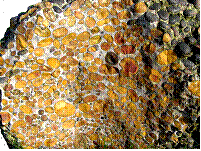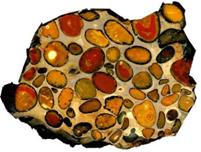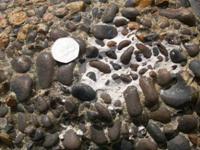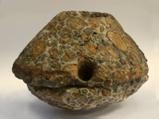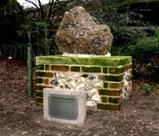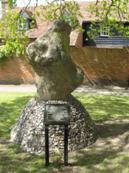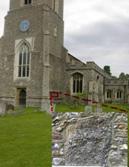
Harrow and Hillingdon Geological Society
Hertfordshire Puddingstone
Home | Monthly Meetings | Field Trips | Exhibitions | Other Activities | Members Pages | Useful Links
Hertfordshire Pudding Stone – some facts, some theories and some unanswered questions.
Jane Tubb
This presentation dealt with the geology and uses of the Hertfordshire Pudding Stone along with some folklore and superstition.
What is it?
Hertfordshire Pudding Stone comprises very well rounded flint pebbles ia a very hard silcrete matrix. It is very hard and cohesive, breaks straight across and can be worked in fine detail. Silcrete cementing is not unusual, as evidenced by the sarsen stones used at Stonehenge, a Roman quern found in Kent, which is also a pudding stone but is not stained and poudin from northern France, which is not well rounded but is well sorted and not stained red.
Hertfordshire Pudding Stone contains stained pebbles in east Hertfordshire, the St Albans area and the Pinner chalk mine but elsewhere in Hertfordshire it tends not to be stained.
|
|
|
Large block of Hertfordshire Pudding Stone |
Polished surface of Hertfordshire Pudding Stone |
White sand matrix exposed on surface of pudding stone |
Where was it formed?
It must be above the Chalk and there is some evidence that it is beneath the London Clay, putting it probably in the Lambeth Group. It is very patchy in occurrence and tends to occur in river valleysor where it has been moved by glaciers. It generally occurs in outliers. At the Colliers End outlier, construction of the A10 bypass came across masses of pudding stone.
When was it formed?
The Chalk contains flint, which seems to be cyclical, in regular bands, as can be seen at Beachy Head, and these may be linked to the orbital cycle. In the Palaeocene, the high sea levels dropped, south-east England was uplifted and there was a period of erosion. Sea levels then rose again and it is suggested the coastline went through Hertfordshire.
The pebbles are very well rounded, probably indicative of a beach, but there is a big difference between beach pebbles and those in the pudding stone, which have a black rim with reddish ochre staining. The staining is almost certainly iron, tan-coloured pebbles being limonite – Fe2O3(x).H2O, the black rim goethite – FEo(OH) and the red staining is probably haematite – Fe2O3. The fact that, when burnt, pudding stone goes red supports the hypothesis that the burning oxidises the iron.
The matrix is very pale to pure white. In some pudding stones it is possibly sandy mud or muddy sand but at Colliers End it is very fine white sand (one specimen had this sand at the surface and it was washed away in the next rainstorm). The cement is silcrete, which forms on the land surface or near the surface in high temperatures where groundwater with dissolved silica percolates through loose sediments and silica precipitates.
The Lambeth Group comprises the Upnor Formation, the Reading Formation and the Woolwich formation. At Colliers End, pudding stone is found right on top of the Chalk and could be a basal conglomerate of the Upnor formation. However, the Dowsett’s Farm borehole shows the Upnor Formation here to be a 3m thick glauconitic clay (of marine origin). During construction of the A120 bypass in the late 1960s-early 1970s, marine Upnor Formation was found on the Chalk with some pebbles at the base and fresh flint.
The Reading Formation cuts down into the Upnor Formation, being fluvial with pebbles. Where the pudding stone is found on top of the Chalk, rivers may have cut down through the Upnor Formation. It is suggested that it may have formed at the Palaeocene/Eocene thermal maximum 55 million years ago.
A possible sequence is that pebbles were rounded on a beach (probably a barrier beach similar to Chesil Beach), then sea level rose and the Upnor Formation was deposited. Sea level dropped, the pebbles were brought in by longshore drift and were stained by iron supplied by rivers from the midlands. Sea level continued to drop, rivers reworked some of the Upnor Formation and deposited the Reading Beds. Exposure of the pudding stone to weathering can lead to crumbling at the edges with loss of silica revealing the matrix, as in the specimen at Colliers End.
Uses of pudding stone
There is evidence of Hertfordshire Pudding Stone being worked for querns (for milling grain) by the Romans. One specimen has been attributed by archaeologists as a Neolithic hammer stone or grinding stone but it could, alternatively, be a Roman tool for finishing off querns.
Because it can be worked in fine detail, it has also been used for jewellery.
|
|
|
|
Roman quern for milling grain |
Puddingstone in Hertford Castle grounds presented by East Herts Geology Club |
The Standon Puddingstone |
Puddingstone incorporated in church wall, Much Hadham |
Folklore and superstition
A lot of blocks of pudding stone have been moved by ice and ended up in gravel pits. These are often used as features, such as the Standon pudding stone, which was in the wall of the churchyard but now stands on the village green (since 1904). It is thought they may have originally marked sites of prehistoric tribal religious meeting places which were subsequently adopted as sites for churches. Indeed, Pope Gregory in AD601 said in a letter to those bringing Christianity to Britain: “Do not destroy these stones the heathens venerate but incorporate them in the churches you build, thus will the heathens more readily come to you”. Possibly in a throwback to that time, local Morris men dance around the Standon stone on Mayday morning.
The pudding stone is also known as:
- Growing stone, because farmers believed it grew in the fields;
- Breeding stone, because it was believed each pebble released by weathering would form another piece of pudding stone; and Hag stone or Witch stone, because it was supposed to ward off evil if you put a lump on your doorstep.
